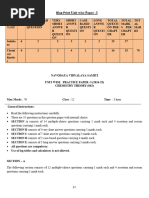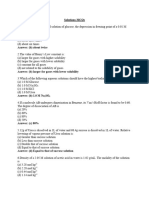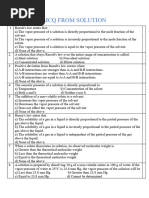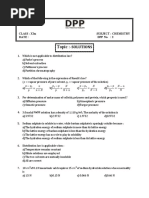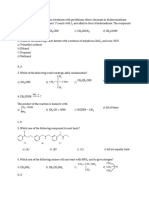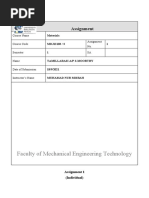Prelim5 MCQ PDF
Prelim5 MCQ PDF
Uploaded by
anandyadav090Copyright:
Available Formats
Prelim5 MCQ PDF
Prelim5 MCQ PDF
Uploaded by
anandyadav090Original Title
Copyright
Available Formats
Share this document
Did you find this document useful?
Is this content inappropriate?
Copyright:
Available Formats
Prelim5 MCQ PDF
Prelim5 MCQ PDF
Uploaded by
anandyadav090Copyright:
Available Formats
PROF.
ANAND YADAVS CHEMISTRY PRIVATE TUITIONS
PRELIM -5 ( SOLID STATE , SOLN COLL , THERMO , ELECTRO )
1) A single substance that exists in two or
more forms is called.
a) Polymorphous
b) Amorphous
c) Isomorphous
d) Mono-morphous
2) Diamond is a
a) Metallic crystal
b) Covalent crystal
c) Ionic crystal
d) Molecular crystal
3) The ratio of close packed atoms to
tetrahedral holes in cubic packing is
a) 1:1
b) 1:2
c) 2:1
d) 1:3
4)
a)
b)
c)
d)
The major binding force in silicon is
Ionic bond
Covalent bond
Dipole-dipole attraction
Induced dipole-dipole attraction
5)
a)
b)
c)
d)
6)
The major binding force of graphite is
Ionic bond
Covalent bond
Hydrogen bond
London force
The number of tetrahedral sites per
sphere in ccp structure is,
1
2
3
4
a)
b)
c)
d)
7) The packing efficiency for a body
centred cubic structure is
12) When NaCl is added to water.
a) Freezing point is raised
b) Freezing point does not change
a)
b)
c)
d)
50 MIN
0.42
0.53
0.68
0.82
8) Due to Frenkel defect the density of
ionic solid
a) Increases
b) Decreases
c) Remains same
d) Fluctuates
9) An ionic crystal lattice has +/ radius
ratio of 0.524. Its coordination number
is
a) 2
b) 4
c) 6
d) 8
10) An ionic compound occurs in fcc
type crystal structure with B ion at the
centre of each face and A ion occupying
corners of the cube. Give the formula
.
a) 3
b) 4
c) 3
d) 4
11) In crystalline solid few of the cations
moved from their positions into the
interstitial position. The defect is called
as,
a) Interstitial defect
b) Frenkel defect
c) Schottky defect
d) Line defect
c) Boiling point is depressed
d) Boiling point is raised
13) Which of the following 0.1 M aqueous solutions will exert highest osmotic pressure?
a) NaCl
c) MgSO4
b) BaCl2
d) Al2(SO4)3
14) According to the Raoults law, the relative lowering of vapour pressure is equal to the
a) mole fraction of solvent
c) mole fraction of solute
PROF. ANAND YADAVS CHEMISTRY PRIVATE TUITIONS
PRELIM -5 ( SOLID STATE , SOLN COLL , THERMO , ELECTRO )
b) independent of mole fraction of solute
50 MIN
d) molality of solution
15) Partial pressure of solvent in solution of non-volatile solute is given by equation,
a) = 2
c) = 1
b) =
d) = 1
16) When partial pressure of solvent in solution of non-volatile solute is plotted against its mole
fraction, nature of graph is
a) a straight line passing through origin
b) a straight line parallel to mole fraction of solvent
c) a straight line parallel to vapour pressure of solvent
d) a straight line intersecting vapour pressure axis.
17) Lowering of vapour pressure of solution
a) is a property of solute
c) is a property of solute as well as solvent
b) is a property of solvent
d) is a colligative property
18) The determination of molar mass from elevation in boiling point is called as
a) cryoscopy
c) ebullioscopy
b) osmometry
d) spectroscopy
19) Vapour pressure of solution of non volatile solute is always
a) equal to the vapour pressure of pure solvent
b) higher than vapour pressure of pure solvent
c) lower than vapour pressure of pure solvent
d) constant
20) In osmosis
a) Solvent molecules pass from high concentration of solute to low concentration.
b) Solvent molecules pass from a solution of low concentration of solute to a solution of high
concentration of solute.
c) Solute molecules pass from low concentration to high concentration
d) Solute molecules pass from high concentration to low concentration
21) Abnormal molar mass is produced by
a) association of solute
b) dissociation of solute
c) both association and dissociation of solute
d) separation by semipermeable membrane
22) Which of the following aqueous solutions will have minimum elevation in boiling point?
a) 0.1M KCl
c) 1M AlPO4
b) 0.05M NaCl
d) 0.1M MgSO4
23) Which of the following will have maximum depression in freezing point?
a) 0.5M Li2SO4
c) 1M KCl
b) 0.5M Al2(SO4)3
d) 0.5M BaCl
PROF. ANAND YADAVS CHEMISTRY PRIVATE TUITIONS
PRELIM -5 ( SOLID STATE , SOLN COLL , THERMO , ELECTRO )
25) The heat evolved in the following reaction
() + () (), =
to produce 9g of water is
a) 484 kJ
b) 121 103 J
c) 242 kJ
d) 968 kJ
26) When a sample of an ideal gas is allowed to
expand at constant temperature against an
stmospheric pressure,
a) Surroundings does work on the system
b) U = 0
c) No heat exchange takes place between the
system and surroundings
d) Internal energy of the system increases.
27) In what reaction of the following, work is
done by the system on the surroundings?
a) () ()
b) 32 () 23 ()
c) 2 () + 2 () 2 ()
d) 2 () + 32 () 23 ()
28) In the reaction, () + ()
, = , if 2 mol of reacts
with , then U is equal to
a) -184 kJ
b) -368 kJ
c) Zero
d) +368 kJ
29) For which of the following substances
is not zero
a) Ca(s)
b) He(g)
c) P(red)
d) CH3OH(l)
30) If for a reaction H is negative and S is
positive then the reaction is
a) Spontaneous at all temperatures
b) Non-spontaneous at all temperatures
c) Spontaneous only at high temperatures
d) Spontaneous only at low temperatures
31) The relationship between of a reaction
and its equilibrium constant is
a) = 1
b) = 1
50 MIN
1
c) = 1
d) = 1
32) For the conversion of liquid to solid below
the melting point of solid
(a) is negative and the process is
spontaneous
(b) is positive and the process is
spontaneous
(c) is positive and the process is nonspontaneous (d) is zero and the process is at
equilibrium.
33) Which of the following conditions
guarantee that a reaction is spontaneous at
constant T and P?
a) Entropy of system increases
b) Enthalpy of system decreases
c) Entropy of system decreases and that of
surroundings increases
d) Gibbs energy of the system decreases.
34) Which of the following processes nonspontaneous?
a) Dissolving KCl in water
b) Mixing of iodine vapour and nitrogen gas
c) Decomposition of NaCl to Na(s) and
Cl2(g)
d) Freezing of water at 270K.
35)For which of the following reactions S in
negative?
a) () + 2 () 2 ()
b) 2 () 2 ()
c) 3 () () + 2 ()
d) 2 () 2()
36) A gas expands in volume from 2L to 5L
against a pressure of 1 atm at constant
temperature. The work done by the gas will be
a) 3J
b) -303.9 J
c) -303.9 L atm
d) 303.9 L.atm
37) Given the reaction,
() + () (),
= .
The enthalpy of formation of NH3 is
a) -92.6 kJ
b) 92.6 kJ mol-1
c) -46.3 kJ mol-1
d) -185.2 kJ mol-1
38. The number of electrons that have a total
charge of 965 coulombs is
PROF. ANAND YADAVS CHEMISTRY PRIVATE TUITIONS
PRELIM -5 ( SOLID STATE , SOLN COLL , THERMO , ELECTRO )
a) 6.022 1023
b) 6.022 1022
c)
6.022 1021
d) 3.011 1023
39. The time required to produce 2F of
electricity with a current of 2.5 amperes is
a) 1.34h
b) 1200min
c)
50000s
d) 1.5h
40. The strongest oxidizing agent among the
species In3+ (E0=1.34V), Au3+ (E0=1.4V,
Hg2+ (E0=0.86V), Cr3+ (E0=0.74V) is
a) 3+
b) 3+
c)
2+
d) 3+
41. The value of constant in Nernst equation
=
at 25 is
a) 0.0592
b) 0.0592
c)
25.7
d) 0.0296
42. The reaction, () + +()
() + ()
with
the
standard
potentials,
= . , =
+. , is
a) Spontaneous in reverse direction
b) Spontaneous in forward direction
c)
At equilibrium
d) Non-spontaneous in reverse direction.
43. Daniel cell operates under nonstandard
state conditions. If the equation of the cell
reaction is multiplied by 2 then
a) E and E0 remain unchanged
b) E is doubled
c)
n remains unchanged in Nernst
equation.
d) Q is halved in Nernst equation.
44. Consider the cell,
| () | +() || ()| (). if the
standard cell potential is 0.54V then the
standard potential for cathode half reaction
will be
a) 0
b) 0.54
c)
+0.54V
d) 1.08
50 MIN
45. Consider the cell
| () | () () | () | .
if the concentration of HCl is increased, the
cell potential will
a) Increase
c) Decrease
b) remain the same d) become maximum
46. The standard potential for the cell reaction
() + +() +() + ()
where = . , = . is
a) 0.52
b) 0.52
c)
1.2V
d) +1.2
47. G0 for the reaction
+() + () +() +
(), where standard potential for silver
half cell reaction is 0.8V, will be
a) 77.2
b) +77.2
c)
154.4
d) 38.6
48. The following reaction occurs in a galvanic
cell + + + . If +,+ =
+. and
, the
+ = .
standard cell potential will be
a) 0.68
b) 0.36
c)
0.36
d) 0.68
49. The SI unit of molar conductivity is
a) 2 1
b) 2 1
c)
2
d) 2 1
50. Consider the following half reactions and
choose the correct alternative
i. () + () =
.
ii. () + () =
.
iii. () + ()
=
.
a) Br2 cannot oxidize Ib) Cl2 can oxidize Br- but not Ic)
I2 con oxidize Cld) Br2 can oxidize I- but not Cl-
You might also like
- Preboard Answer KeyDocument11 pagesPreboard Answer Keykennethbetouched88% (8)
- Etoos Solid State PS SirDocument27 pagesEtoos Solid State PS SirGyandeep KalitaNo ratings yet
- CHEMISTRYMOCK8THJULY Sqphqwtkyx4kr6bDocument5 pagesCHEMISTRYMOCK8THJULY Sqphqwtkyx4kr6barunisingh967No ratings yet
- Xi Chem 13.01.24Document2 pagesXi Chem 13.01.24faraazahmed70058No ratings yet
- Chemistry 12 Term 1 (2023 24)Document8 pagesChemistry 12 Term 1 (2023 24)lardemuydiNo ratings yet
- 12th KCET Chemistry PaperDocument8 pages12th KCET Chemistry PaperGokul yadavNo ratings yet
- Practice Questions1734447699557Document10 pagesPractice Questions1734447699557mindl0ess.99No ratings yet
- XII PREBOARD 1STDocument4 pagesXII PREBOARD 1STSSS Convent School Sri GanganagarNo ratings yet
- Xi Chemistry Full Portion One Marks 1Document3 pagesXi Chemistry Full Portion One Marks 1ssanthoshjs47No ratings yet
- CAPTITAL PUBLIC SCHOOL12Document10 pagesCAPTITAL PUBLIC SCHOOL12ishaanjha.inNo ratings yet
- Chemistry 12 ARODocument6 pagesChemistry 12 AROpriyanshusao9263No ratings yet
- JEE - Chemistry - Chemical KineticsDocument27 pagesJEE - Chemistry - Chemical Kineticsdaiwikchilukuri321No ratings yet
- Ch1. Solutions Type 3. Multiple Choice Questions RememberingDocument9 pagesCh1. Solutions Type 3. Multiple Choice Questions RememberingAakriti JainNo ratings yet
- CHM 231 Summer Tutorial Questions 2022Document10 pagesCHM 231 Summer Tutorial Questions 2022hhude65No ratings yet
- Chemistry MCQsDocument13 pagesChemistry MCQssopmaNo ratings yet
- Edited worksheet-Rev-Physical ChemDocument6 pagesEdited worksheet-Rev-Physical Chemrsinghvi13No ratings yet
- Practice Test Chapter 12 and 13Document9 pagesPractice Test Chapter 12 and 13luis arauzNo ratings yet
- PT1 Test Class 12 FinalDocument8 pagesPT1 Test Class 12 FinalAakansha BhandariNo ratings yet
- MCQ chemistryDocument27 pagesMCQ chemistrycekiy97805No ratings yet
- DPP 2 6Document3 pagesDPP 2 6GnaneshwarNo ratings yet
- NEET CHEM 2 10-01-25Document6 pagesNEET CHEM 2 10-01-25vidyashrayacademyiitneetNo ratings yet
- Chem Questions and Answers 151 FinalDocument12 pagesChem Questions and Answers 151 FinalTom TeslaNo ratings yet
- CHEMICAL KINETICS-1 - WordToPdfDocument71 pagesCHEMICAL KINETICS-1 - WordToPdfdevasaran72007No ratings yet
- CHEMISTRY MCQ'sDocument23 pagesCHEMISTRY MCQ'smanish.kh04No ratings yet
- Test 1Document3 pagesTest 1listentolofi3333No ratings yet
- MCQs For Class XII ChemistryDocument29 pagesMCQs For Class XII Chemistryjkc collegeNo ratings yet
- Chemistry 101 Final Exam-B Fall 2014Document13 pagesChemistry 101 Final Exam-B Fall 2014Kristopher Park SolivenNo ratings yet
- Thermodynamics AssignmentDocument6 pagesThermodynamics AssignmentPrayagni NagarNo ratings yet
- Chemistry Foram QP 01 B M KDocument3 pagesChemistry Foram QP 01 B M Kmuttumudennavar99No ratings yet
- PHYSICAL CHEMISTRY ONE MARK TESTDocument3 pagesPHYSICAL CHEMISTRY ONE MARK TESTmurugank212No ratings yet
- 6.thermodynamics (Ncert Lines)Document26 pages6.thermodynamics (Ncert Lines)mirzarehanbaig005No ratings yet
- Chem. Assig.Document8 pagesChem. Assig.aryan asliaNo ratings yet
- QWQWDocument6 pagesQWQWmaduenofurtawzib.c6.1.33No ratings yet
- Chemistry Sqp-Hy - Class-12 (2024)Document4 pagesChemistry Sqp-Hy - Class-12 (2024)Saahil ZahirNo ratings yet
- Term 2 Online Class Xi Chemistry 043Document4 pagesTerm 2 Online Class Xi Chemistry 043kumaryashxd07No ratings yet
- Tutorial Kit (Chemistry-100 L) - Vol. 2Document30 pagesTutorial Kit (Chemistry-100 L) - Vol. 2Terhemen AnjiraNo ratings yet
- Chemistry QpaperDocument6 pagesChemistry Qpaperadityasasmal647No ratings yet
- Chemical Kinetics 1Document103 pagesChemical Kinetics 1drvssssmcrobertganjNo ratings yet
- 218 FinalDocument17 pages218 FinalmhaymourNo ratings yet
- Class 11 Biology Topic Wise Line by Line Chapter 5 ThermodynamicsDocument43 pagesClass 11 Biology Topic Wise Line by Line Chapter 5 ThermodynamicsArtham ResourcesNo ratings yet
- Aieee 2009 Model Paper 1Document7 pagesAieee 2009 Model Paper 1Vicky_Munnetul_7889No ratings yet
- WWW - Chemre.In: Ranjan E-InstituteDocument24 pagesWWW - Chemre.In: Ranjan E-InstituteSricharan100% (1)
- AP Ch. 12-13 Kinetics & Equilibrium Review AnswersDocument35 pagesAP Ch. 12-13 Kinetics & Equilibrium Review AnswersRucar Rad0% (1)
- 34 Chemistry SV 2024 Exam-1Document13 pages34 Chemistry SV 2024 Exam-1qzglsefafNo ratings yet
- Ecat 2013Document6 pagesEcat 2013Asad ullahNo ratings yet
- IE Review Chemistry TrackDocument3 pagesIE Review Chemistry TrackRugi Vicente RubiNo ratings yet
- Solutions AssignmentsDocument6 pagesSolutions Assignmentsvartikajaiswal989No ratings yet
- MRT MDocument8 pagesMRT MSrijan JaiswalNo ratings yet
- 12 Chemistry XII PaperDocument4 pages12 Chemistry XII PaperPrinceNo ratings yet
- SolutionsDPP EndgameDocument17 pagesSolutionsDPP EndgameSaronik PalNo ratings yet
- Namma Kalvi 11th Chemistry Revision Test Question Papers EM 221210Document10 pagesNamma Kalvi 11th Chemistry Revision Test Question Papers EM 221210forever gamersNo ratings yet
- 11che0i QPDocument7 pages11che0i QPanu.panchu007No ratings yet
- CHEM191 Progress Test 2020Document8 pagesCHEM191 Progress Test 2020AshleyNo ratings yet
- CHE102FF03PDocument5 pagesCHE102FF03PDhrumilParikhNo ratings yet
- DPP 2Document3 pagesDPP 2rajeev sekhriNo ratings yet
- Wa0010Document5 pagesWa0010vaishaliadbhai99No ratings yet
- NEET Sample (Model-5) Question Paper With Answer Keys - Free PDF DownloadDocument40 pagesNEET Sample (Model-5) Question Paper With Answer Keys - Free PDF Downloadt.nishar61258No ratings yet
- namma_kalvi_12th_chemistry_volume_2_book_inside_1_mark_questions_with_answers_em_216669Document36 pagesnamma_kalvi_12th_chemistry_volume_2_book_inside_1_mark_questions_with_answers_em_216669thivathiva671No ratings yet
- NEET National Eligibility Cum Entrance Test Chemistry Class 11 + 12 Volume I + Volume IIFrom EverandNEET National Eligibility Cum Entrance Test Chemistry Class 11 + 12 Volume I + Volume IINo ratings yet
- Interstitial Void SpacesDocument4 pagesInterstitial Void SpacessaleemNo ratings yet
- Material Science ..Crystal StructureDocument24 pagesMaterial Science ..Crystal StructureSajal MathurNo ratings yet
- Metallurgy & Materials Science: S3 MechanicalDocument108 pagesMetallurgy & Materials Science: S3 MechanicalDrRoja A RNo ratings yet
- Notes 221006 051612Document30 pagesNotes 221006 051612Ramitha . VNo ratings yet
- ChemistryDocument18 pagesChemistryjaya bhaNo ratings yet
- Material Science and Engineering Bme303 2022 Scheme Vtu NotesDocument125 pagesMaterial Science and Engineering Bme303 2022 Scheme Vtu Noteskarthikck5434No ratings yet
- 7.2.3 Hydrogen CrackingDocument18 pages7.2.3 Hydrogen Crackingডঃ শুভম চ্যাটার্জীNo ratings yet
- Photovoltaic Material:: Why Glass Is Considered As A Super Cooled Liquid?Document8 pagesPhotovoltaic Material:: Why Glass Is Considered As A Super Cooled Liquid?SsNo ratings yet
- CLS Aipmt 19 20 XII Che Study Package 1 Level 1 Chapter 1Document20 pagesCLS Aipmt 19 20 XII Che Study Package 1 Level 1 Chapter 1ShubanghiNo ratings yet
- Anna University 1st Year 2017 Regulation Engineering Notes For All Department, 1st, 2nd Semester - BrainkartDocument143 pagesAnna University 1st Year 2017 Regulation Engineering Notes For All Department, 1st, 2nd Semester - BrainkartM.V. TVNo ratings yet
- Faculty of Mechanical Engineering Technology: AssignmentDocument4 pagesFaculty of Mechanical Engineering Technology: AssignmentpusparasiNo ratings yet
- Welcome To MLL 100: Introduction To Materials Science and Engineering (3-0-2)Document112 pagesWelcome To MLL 100: Introduction To Materials Science and Engineering (3-0-2)Rishi GandhiNo ratings yet
- AITS 1920 FT I JEEA Paper 2 PDFDocument16 pagesAITS 1920 FT I JEEA Paper 2 PDFUtkarsh25% (4)
- Instant Download Bands and Photons in III-V Semiconductor Quantum Structures Igor Vurgaftman PDF All ChapterDocument53 pagesInstant Download Bands and Photons in III-V Semiconductor Quantum Structures Igor Vurgaftman PDF All Chapterlayaleoubrik100% (4)
- Rekap Pukpes Att - OlahDocument51 pagesRekap Pukpes Att - OlahRicky PratamaNo ratings yet
- PHYSICAL JAM PYQ QuestionsDocument46 pagesPHYSICAL JAM PYQ QuestionsSandrapati ArunkumarNo ratings yet
- Crystal Physics Lect 1Document48 pagesCrystal Physics Lect 1r. balakrishnanNo ratings yet
- HW 4 SolutionDocument5 pagesHW 4 Solutionneha patelNo ratings yet
- The Solid State WorkbookDocument31 pagesThe Solid State WorkbookledrapotriNo ratings yet
- MCQ Question Bank For Unit 1: A Is Lattice Parameter) Is (B) A/2Document14 pagesMCQ Question Bank For Unit 1: A Is Lattice Parameter) Is (B) A/2Shubham MagarNo ratings yet
- Periodic TableDocument3 pagesPeriodic Tablebmhyx8xc2No ratings yet
- 1.SolidState KCET PYQsDocument1 page1.SolidState KCET PYQsgangi reddy100% (1)
- II Pu Online Unit Test-ScienceDocument24 pagesII Pu Online Unit Test-ScienceKomal GowdaNo ratings yet
- Practice Paper For JEE Advanced.Document18 pagesPractice Paper For JEE Advanced.Mahesh BabuNo ratings yet
- UT SSRG1 Test-1 Code-A1Document6 pagesUT SSRG1 Test-1 Code-A1ratnamNo ratings yet
- Prince Singh: Physical & Inorganic ChemistryDocument5 pagesPrince Singh: Physical & Inorganic ChemistryJatin SinglaNo ratings yet
- Chromium Added Zinc BathDocument9 pagesChromium Added Zinc BathHerdisNo ratings yet
- Semiconductor Physics and Devices CH1Document6 pagesSemiconductor Physics and Devices CH1steven8899567% (12)
- GEG #1 Mobil Pegasus 805Document2 pagesGEG #1 Mobil Pegasus 805dhavit wijayantoNo ratings yet






